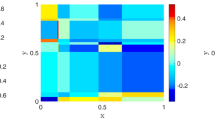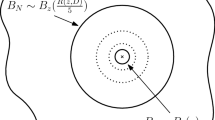Abstract
Completing the study initiated by Mounaix and Collet (J Stat Phys 143:139–147, 2011), we investigate the realizations of a Gaussian random field in the limit where a given (general) quadratic form of the field is large. Concentration in \(L^2\) and in probability is proved under mild conditions and the resulting quasi-deterministic behavior of the field is given. Applications to a large local quadratic form are considered in two specific cases. In particular, the quasi-deterministic structure of a Gaussian random flow with a large local helicity at some given point is determined explicitly.
Similar content being viewed by others
Notes
Such a basis exists as \(\fancyscript{H}\) is a separable Hilbert space.
References
Mounaix, Ph, Collet, P.: Linear amplifier breakdown and concentration properties of a Gaussian field given that its \(L^2\)-norm is large. J. Stat. Phys. 143, 139–147 (2011)
Mounaix, Ph, Divol, L.: Breakdown of hot-spot model in determining convective amplification in large homogeneous systems. Phys. Rev. Lett. 93(185003), 1–4 (2004)
Moffat, H.K.: Magnetic Field Generation in Electrically conducting Fluids. Cambridge University Press, Cambridge (1978)
Boccotti, P.: Wave Mechanics for Ocean Engineering. Elsevier oceanography series, 64. Elsevier, Amsterdam (2000). references therein
Adler, R.J., Taylor, J.E.: Random Fields and Geometry. Springer monographs in mathematics. Springer, New York (2007)
Gelfand, I.M., Vilenkin, N.Y.: Generalized Functions, vol. IV. Academic Press, New York (1964)
Adler, R.J.: The Geometry of Random Fields, Wiley Series in Probability and Mathematical Statistics. Wiley, Chichester (1981)
Abramowitz, M., Stegun, I.A.: Handbook of Mathematical Functions. Applied mathematics series. National Bureau of Standards, Washington (1985)
Acknowledgments
The author warmly thanks Harvey A. Rose for providing valuable insights, and in particular for pointing out the problem solved in Sect. 4.2, which was one of the motivations for this work. He also thanks Girish Sharma, Pierre Collet, and Satya N. Majumdar for useful discussions, as well as Joel L. Lebowitz for interest and useful discussions on related subjects.
Author information
Authors and Affiliations
Corresponding author
Appendix: Proof of Proposition 1 for a Real Field (\(\varvec{\fancyscript{H}=L^2(\Lambda )\otimes \mathbb {R}^N}\))
Appendix: Proof of Proposition 1 for a Real Field (\(\varvec{\fancyscript{H}=L^2(\Lambda )\otimes \mathbb {R}^N}\))
For a real field, i.e. for \(\fancyscript{H}=L^2(\Lambda )\otimes \mathbb {R}^N\), one has \(\langle \varphi \vert \hat{O}\vert \varphi \rangle = \langle \varphi \vert \hat{O}^S\vert \varphi \rangle \) and the symmetric operator to be considered is actually \(\hat{O}^S\), the symmetric part of \(\hat{O}\). (It follows in particular that \(\hat{O}\) needs not be symmetric as it always appears through its symmetric part only).
We give the proof for “\(\pm =+\)”. (The proof for “\(\pm =-\)” is similar). To estimate the two conditional probabilities on the right-hand side of (9) we first need to bound \(\mathbb {P}(\langle \varphi \vert \hat{O}^S\vert \varphi \rangle >u)\) from below. Let \(\rho (v)\) denote the probability distribution function (pdf) of \(\sum _{\lbrace 1\le n\le g_1\rbrace \cup \lbrace n<0\rbrace }\lambda _n t_n^2\). One has the integral representation
For \(v\rightarrow +\infty \), the leading asymptotic behavior of (79) is determined by the vicinity of the singularity at \(k=-i/2\lambda _1\) and one gets
where \(s=1-2ik\lambda _1\). (Note that \(\hat{M}\) being trace class ensures that the product in front of the integral exist). The remaining s-integral is easily obtained from [8, see Eqs. 29.3.3 to 29.3.6, p. 1023]. One finds
from which it follows that for every \(0<\alpha <1\), there is \(v_0 >0\) such that for every \(v>v_0\)
From (82) and the lower bound
one finds that for \(u>v_0\),
with
From the asymptotics
it follows that there is \(v_1>0\) such that for every \(u>v_1\)
Injecting (86) into (84), one finds that for u large enough (i.e. \(u>\max \lbrace v_0,v_1\rbrace \))
[Note that if \(g_1>1\), one can as well follow the same calculation as in the complex case, i.e. without using (86), and \((1-\alpha )^2\) is replaced with \(1-\alpha \) in (85)]. First, we estimate the conditional probabilities \(\mathbb {P}_u\left( \Vert \overline{\varphi }\Vert _2^2<a\right) \). One has
The matrix \(\langle \lambda _i\vert \hat{C}\vert \lambda _j\rangle \) is a \(g_1\times g_1\) positive definite symmetric (real) matrix. Let \(\tilde{\mu }_1\ge \tilde{\mu }_2\ge \cdots \ge \tilde{\mu }_{g_1}\) denote its eigenvalues and \(\lbrace \vert \tilde{\mu }_i\rangle \rbrace \) the corresponding orthonormal basis of eigenvectors. For every realization of the \(t_i\) one has
where
From (90) one finds that the \(\tilde{t}_i\) have the same statistical properties as the \(t_i\) (i.e. they are i.i.d. real Gaussian random variables with \(\langle \tilde{t}_i\rangle =0\) and \(\langle \tilde{t}_i^2\rangle =1\)), with
Using (90) and (91) on the right-hand side of (88) and dropping the tilde (because the \(\tilde{t}_i\) and the \(t_i\) have the same statistical properties), one obtains
It follows from \(\mu _n>0\) for every n and (2) that \(\tilde{\mu }_i =\langle \tilde{\mu }_i\vert \hat{C}\vert \tilde{\mu }_i\rangle >0\) for every i, and from \(\hat{M}\) being trace class that \(g_1<+\infty \). Thus,
and (92) is bounded above by
where we have used the statistical independence of the \(t_i\) (second line), and the fact that the probability in the integrand vanishes identically for \(x<u-\lambda _1 a/\tilde{\mu }_{min}\) (third line). Now, by exponential Markov inequality, one has for every positive \(c<1/2\lambda _{g_1+1}\),
and by taking \(c=(\lambda _1^{-1}+\lambda _{g_1+1}^{-1})/4\), one gets
with
The existence of the product on the right-hand side of (96) is ensured by \(\hat{M}\) being trace class. Finally, it follows from the two estimates (87) and (95) that for u large enough \(\mathbb {P}_u\left( \Vert \overline{\varphi }\Vert _2^2<a\right) \) is bounded above by
We now estimate the limit \(\lim _{u\rightarrow +\infty }\mathbb {P}_u\left( \Vert \delta \varphi \Vert _2^2>\varepsilon a\right) \). One has
with
where H(v) is the Heaviside step function and \(S_{g_1}\) is the unit sphere surface area in a \(g_1\)-dimensional space (\(S_1=2\)).
If \(g_1>1\) one can follow exactly the same line as in the complex field case. One finds that for every \(\alpha >0\), there is \(v_2 >0\) such that for every \(u>v_2\)
Taking \(0<\alpha <1\), it follows from (87), (98), and (100) that for u large enough (i.e. \(u>\max \lbrace v_0,v_1,v_2\rbrace \))
with
Using (101) to estimate \(\mathbb {E}_u\left[\exp \left( c\Vert \delta \varphi \Vert _2^2\right) \right]\), one finds that for u large enough
where \(C_4(c)\) is an infinite product of Gaussian integrals the existence of which is ensured if the matrix
is (strictly) positive definite, and the matrix
is trace class, with i and j \(\notin [1,\, g_1]\). The latter condition is fulfilled by \(\hat{M}\) and \(\hat{C}\) being trace class. The former one requires \(0<c<(1-\lambda _{g_1+1}/\lambda _1)/2\mu _1\), which follows from \(\Vert \hat{C}\Vert = \mu _1 <+\infty \) and \(\min \left\{ 1,\, 1-\lambda _i/\lambda _1\right\} \ge 1-\lambda _{g_1+1}/\lambda _1>0\) for \(i\notin [1,\, g_1]\). Thus, there exists \(c>0\) such that \(C_4(c)<+\infty \), and by exponential Markov inequality and Eq. (103) one finds that for u large enough
The end of the proof is the same as in the complex case.
If \(g_1=1\) a different approach is needed because, in this case, \(1/\sqrt{v}\) is not an increasing function of v and one cannot use the arguments leading from (99) to (100). In the following we write \(\sigma =\sum _{i>1}\lambda _i t_i^2\) and for fixed \(0<\varepsilon <1\) we consider the two complementary domains \(\sigma <(1-\varepsilon )u\) and \(\sigma \ge (1-\varepsilon )u\) respectively.
In the first domain, one can bound (99) above by making the change of variable \(v\rightarrow v-\sigma /\lambda _1\) on the right-hand side of (99) and using the fact that \(1/\sqrt{v}\) is a decreasing function of v. One obtains
which is very similar to (100) with a different constant. Taking \(0<\alpha <1\), it follows from (87), (98), and (105) that for u large enough (i.e. \(u>\max \lbrace v_0,v_1\rbrace \))
with
Using first (106) and then \({\varvec{1}}_{\lbrace \sigma <(1-\varepsilon )u\rbrace }\le 1\) to estimate \(\mathbb {E}_u\left[\exp \left( c\Vert \delta \varphi \Vert _2^2\right) {\varvec{1}}_{\lbrace \sigma <(1-\varepsilon )u\rbrace }\right]\), one finds
where \(C_4(c)\) is the same infinite product of Gaussian integrals as in (103).
In the second domain, we use \(\mathbb {P}[t_1^2>(u-\sigma )/\lambda _1]\le 1\) to bound (98) trivially by
From (87), (109), and Hölder’s inequality it follows that for u large enough,
with \(p>1\), \(1/p+1/q=1\), and where we have used \(\mathbb {E}\left[\exp \left( c\Vert \delta \varphi \Vert _2^2\right) \right]\le C_4(c)\) (to avoid introducing another constant). The probability on the right-hand side of (110) can be estimated from the asymptotic evaluation of its integral representation for large u. Skipping the details, one finds that for every \(\alpha >0\), there is \(v_2>0\) such that for every \(u>v_2\)
where \(C_5(\alpha )\) is a constant. Injecting (111) into (110) one obtains, for u large enough (i.e. \(u>\max \lbrace v_0,v_1,v_2\rbrace \))
Write
It remains to fix \(0<\varepsilon <1-\lambda _2/\lambda _1\), \(1<p<(1-\varepsilon )\lambda _1/\lambda _2\), and \(0<c<(1-\lambda _{g_1+1}/\lambda _1)/2q\mu _1\) and one has, for u large enough,
with \(\gamma (\varepsilon ,p)>0\) and where \(C_6(\alpha )\) is a constant. Note that c is chosen such that \(C_4(qc)\) on the right-hand side of (112) exists, and since \(C_4(c)\le C_4(qc)\) by \(q>1\), it follows that \(C_4(c)\) on the right-hand side of (108) exists too. By exponential Markov inequality, Eq. (108), and Eq. (113) one finds that for u large enough
Finally, using the estimates (97) with \(g_1=1\) and (114) on the right-hand side of (9) and taking the limit \(u\rightarrow +\infty \), one obtains
and \(a>0\) being arbitrary completes the proof of Proposition 1 for a real field [The right-hand side of (115) can be made arbitrarily small]. \(\square \)
Rights and permissions
About this article
Cite this article
Mounaix, P. Quasi-Deterministic Properties of Random Gaussian Fields Constrained by a Large Quadratic Form. J Stat Phys 160, 561–582 (2015). https://doi.org/10.1007/s10955-015-1278-x
Received:
Accepted:
Published:
Issue Date:
DOI: https://doi.org/10.1007/s10955-015-1278-x




